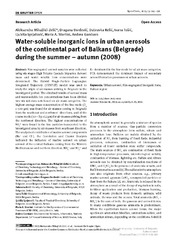Prikaz osnovnih podataka o dokumentu
Water-soluble inorganic ions in urban aerosols of the continental part of Balkans (Belgrade) during the summer - autumn (2008)
| dc.creator | Mihajlidi-Zelić, Aleksandra | |
| dc.creator | Đorđević, Dragana S. | |
| dc.creator | Relić, Dubravka | |
| dc.creator | Tosic, Ivana | |
| dc.creator | Ignjatovic, Ljubisa | |
| dc.creator | Stortini, Angela Maria | |
| dc.creator | Gambaro, Andrea | |
| dc.date.accessioned | 2018-11-22T00:31:37Z | |
| dc.date.available | 2018-11-22T00:31:37Z | |
| dc.date.issued | 2015 | |
| dc.identifier.issn | 2391-5420 | |
| dc.identifier.uri | https://cherry.chem.bg.ac.rs/handle/123456789/1719 | |
| dc.description.abstract | Size-segregated aerosol samples were collected using six stages High Volume Cascade Impactor. Aerosol mass and water soluble ions concentrations were determined. The Hybrid Single-Particle Lagrangian Integrated Trajectory (HYSPLIT) model was used to study the origin of air masses arriving to Belgrade in the investigated period. The obtained results of aerosol mass and water-soluble ion concentrations have been divided into six sub-data sets based on air mass categories. The highest average mass concentration of the fine mode (D-p lt = 0.49 mu m) was found for air masses coming to Belgrade from the southeast and northwest directions, and of the coarse mode (3.0 lt D-p lt = 7.2 mu m) for air masses arriving from the northwest direction. The highest concentrations of SO42- were found in the fine particles transported to the investigated area by air masses from southeast direction. The analysis of contribution of marine aerosol components (Na+ and Cl-), the Correlation and Cluster Analysis indicated the influence of marine aerosol on urban aerosol of the central Balkans coming from the Western Mediterranean and northern direction. NH4+ and SO42- and K+ dominated in the fine mode for all air mass categories. PCA demonstrated the dominant impact of secondary aerosol formation processes on urban aerosols. | en |
| dc.publisher | De Gruyter Open Ltd, Warsaw | |
| dc.relation | info:eu-repo/grantAgreement/MESTD/Basic Research (BR or ON)/172001/RS// | |
| dc.relation | info:eu-repo/grantAgreement/MESTD/Integrated and Interdisciplinary Research (IIR or III)/43007/RS// | |
| dc.relation | info:eu-repo/grantAgreement/MESTD/Basic Research (BR or ON)/176013/RS// | |
| dc.relation | SIMCA project (INTERREG/CARDS-PHARE Adriatic New Neighborhood Programme) [06SER02/01/04] | |
| dc.rights | openAccess | |
| dc.rights.uri | https://creativecommons.org/licenses/by-nc-nd/4.0/ | |
| dc.source | OPEN CHEMISTRY | |
| dc.subject | Urban aerosol | en |
| dc.subject | Size-segregated inorganic ions | en |
| dc.subject | Balkan region | en |
| dc.title | Water-soluble inorganic ions in urban aerosols of the continental part of Balkans (Belgrade) during the summer - autumn (2008) | en |
| dc.type | article | |
| dc.rights.license | BY-NC-ND | |
| dcterms.abstract | Гамбаро, Aндреа; Игњатовиц, Љубиса; Релић, Дубравка; Дордевиц, Драгана; Михајлиди-Зелиц, Aлександра; Стортини, Мариа A.; Тосиц, Ивана; | |
| dc.citation.volume | 13 | |
| dc.citation.issue | 1 | |
| dc.citation.spage | 245 | |
| dc.citation.epage | 256 | |
| dc.identifier.wos | 000355403100030 | |
| dc.identifier.doi | 10.1515/chem-2015-0010 | |
| dc.citation.other | 13(1): 245-256 | |
| dc.citation.rank | M23 | |
| dc.type.version | publishedVersion | |
| dc.identifier.scopus | 2-s2.0-84990931477 | |
| dc.identifier.fulltext | https://cherry.chem.bg.ac.rs/bitstream/id/8794/1717.pdf |


